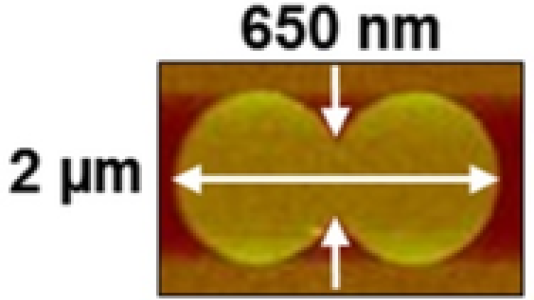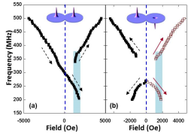
Spin vortices have been the subject of significant scientific interest due to their relevance to the fundamental science and technological implications, such as logic devices for information storage, vortex-based magnonic crystals for information propagation, energy-efficient microwave oscillators and even in bio-medical investigations. The rotation direction for the dynamics of magnetic vortices is determined by the polarity of the vortex core, i.e., the magnetization direction at the center of a magnetic disk. Therefore, for two strongly coupled vortices, such as two touching disks, the frequency of the dynamics depends on whether the relative vortex core polarity is parallel or antiparallel.
Unfortunately, exploring this behavior in an applied magnetic field has been elusive for a long time, since only a parallel core polarity can be established by magnetic field cycling. However, we have established recently that through resonant spin-ordering both the parallel and anti-parallel configuration can be reliably stabilized, which opened up the opportunity for a systematic field-dependent study of the magnetic dynamics for each configuration, which is reported in this work. For the parallel case an antisymmetric field dependence of the resonance frequency is observed, which depends on the relative orientation between the applied magnetic field and both core polarities. On the hand for the anti-parallel core polarities the frequency dependence is symmetric in applied field, and any magnetic field results in a softening of the dynamics. This is due to the fact that in the case of anti-parallel vortex polarities the energy relaxation for the energetically unfavorable (i.e., higher frequency) vortex core dynamic mode is faster and all the energy is transferred to the lower energy mode. This unusual one-way dissipation of energy stems from the complex interplay between magnetostatic coupling and dynamic interactions in the double-vortex system. This basic work is relevant to grand challenges in mesoscale materials science, dynamics of non-equilibrium systems, and in continuing the information technology revolution.
Dynamics of coupled vortices in perpendicular field,Shikha Jain, Valentyn Novosad Frank Y. Fradin, John E. Pearson, and Samuel D. Bader,
Appl. Phys. Lett. 104, 082409 (2014)
